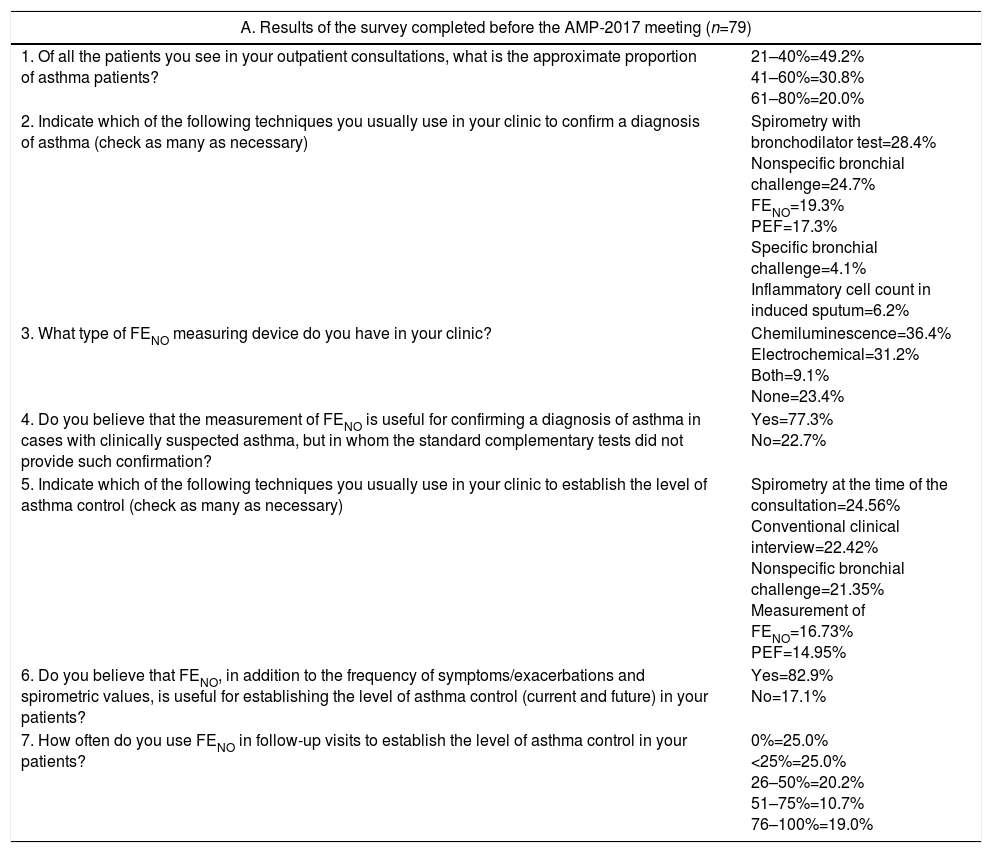Measuring fractional exhaled nitric oxide (FENO) is a non-invasive method for identifying allergic eosinophilic inflammation of the bronchi and activation of the IL-4/IL-13 pathway in the allergic asthma phenotype.1 Its simplicity of use, immediate results, and reasonable cost have made it the procedure of choice among asthma specialists. However, the Global Initiative for Asthma (GINA)2 and the Spanish Guidelines for the Management of Asthma (GEMA)3 diverge in their positioning on this technique. Several recent systematic reviews analyzing the efficacy of this technique have reported favorable results for diagnosis,4 and partially favorable results for determining asthma control.5 This evidence, far from settling the issue, has sparked further debate.
For this reason, a round table discussion on this topic was included in the program of the latest “Asthma Meeting Point” (AMP) conference in 2017. The AMP is a multidisciplinary meeting of asthma experts, the main aim of which is to discuss controversial issues in asthma or matters for which insufficient evidence is available. In total, 144 professionals participated in this meeting, including 87 (60.4%) pulmonologists, 40 (27.8%) allergists, 9 (6.2%) primary care practitioners, and 8 (5.6%) representatives from other areas (pediatrics, internal medicine, and nursing).
Before the meeting, a brief electronic survey on the opinions and attitudes of the attendees toward FENO was conducted. It was completed by 79 professionals, and the results are listed in Table 1A. It was particularly interesting to note that whereas only 19.3% used the method to establish a diagnosis, and 16.7% used it to determine the level of control, 77.3% considered it a useful method for diagnosis and 82.9% for determining asthma control. During the meeting itself, an interactive discussion took place among the audience and 5 of the authors of this article (VP, BGC, LME, LPLL and JMO). Controversial aspects associated with FENO and, primarily, the approach to different clinical cases associated with the usefulness of the technique in the diagnosis and control of asthma were debated. After this discussion, 3 key questions were put to the audience, with several options for response, on which the attendees voted in situ at the end of the meeting (Table 1B). The results were even more favorable than those of the earlier questionnaire: 95.2% of the group believed that FENO was a useful complementary technique in asthma for diagnosis and 90.3% found it useful for determining control (55.3% “in all cases”; plus 35.5% “only in patients with allergic asthma”).
Opinion of Experts Attending the AMP-2017 Meeting on the Use of FENO in the Diagnosis and Control of Asthma: A. Results of the Survey Completed Before the Meeting; and B. Results of the In-Person Vote Taken During the Meeting.
| A. Results of the survey completed before the AMP-2017 meeting (n=79) | |
|---|---|
| 1. Of all the patients you see in your outpatient consultations, what is the approximate proportion of asthma patients? | 21–40%=49.2% 41–60%=30.8% 61–80%=20.0% |
| 2. Indicate which of the following techniques you usually use in your clinic to confirm a diagnosis of asthma (check as many as necessary) | Spirometry with bronchodilator test=28.4% Nonspecific bronchial challenge=24.7% FENO=19.3% PEF=17.3% Specific bronchial challenge=4.1% Inflammatory cell count in induced sputum=6.2% |
| 3. What type of FENO measuring device do you have in your clinic? | Chemiluminescence=36.4% Electrochemical=31.2% Both=9.1% None=23.4% |
| 4. Do you believe that the measurement of FENO is useful for confirming a diagnosis of asthma in cases with clinically suspected asthma, but in whom the standard complementary tests did not provide such confirmation? | Yes=77.3% No=22.7% |
| 5. Indicate which of the following techniques you usually use in your clinic to establish the level of asthma control (check as many as necessary) | Spirometry at the time of the consultation=24.56% Conventional clinical interview=22.42% Nonspecific bronchial challenge=21.35% Measurement of FENO=16.73% PEF=14.95% |
| 6. Do you believe that FENO, in addition to the frequency of symptoms/exacerbations and spirometric values, is useful for establishing the level of asthma control (current and future) in your patients? | Yes=82.9% No=17.1% |
| 7. How often do you use FENO in follow-up visits to establish the level of asthma control in your patients? | 0%=25.0% <25%=25.0% 26–50%=20.2% 51–75%=10.7% 76–100%=19.0% |
| B. In-person vote taken during the AMP-2017 meeting (n=103) | |
|---|---|
| 1. The measurement of FENO can be a useful complementary tool in the diagnosis of asthma in symptomatic patients with inconclusive spirometry | Yes=95.2% No=1.9% Don’t know (no opinion)=2.9% |
| 2. The measurement of FENO, combined with questionnaires and spirometry, can help determine asthma control (current and future risk) | Yes, always in all cases=55.3% Only in patients with allergic asthma=35% No=3.9% Don’t know (no opinion)=5.8% |
| 3. The measurement of FENO is useful for determining adherence to anti-inflammatory treatment in patients with asthma | Yes=65.1% Only in some patients under strict supervision=12.6% No=15.5% Don’t know (no opinion)=6.8% |
AMP: Asthma Meeting Point; FENO: fractional exhaled nitric oxide; PEF: peak expiratory flow.
In short, the opinion of the multidisciplinary group of stakeholders and experts in asthma attending the AMP-2017 meeting was largely favorable to incorporating the measurement of FENO in clinical practice. Until the role of this examination is definitively determined in new studies, the results of this discussion should perhaps be considered in future editions of clinical practice guidelines in asthma.
Please cite this article as: Plaza V, Cosio BG, Entrenas LM, Olaguíbel JM, de Llano LP, Quirce S, et al. Papel de la medición de la FENO en el diagnóstico y control del asma. Debate del grupo multidisciplinar de expertos de la reunión Asma Meeting Point 2017. Arch Bronconeumol. 2018;54:237–238.










